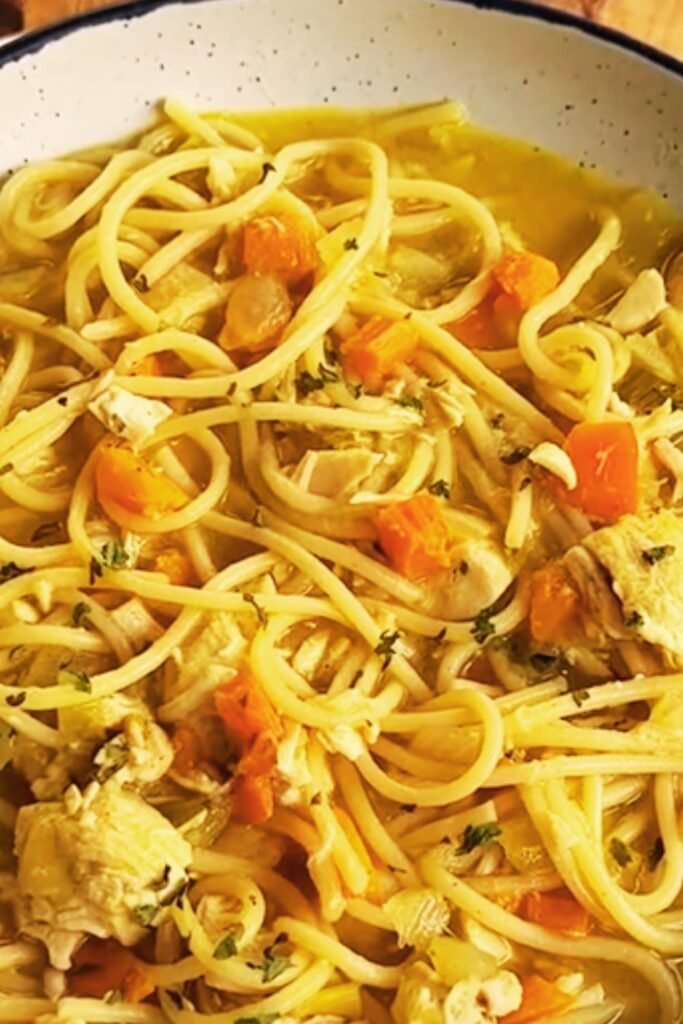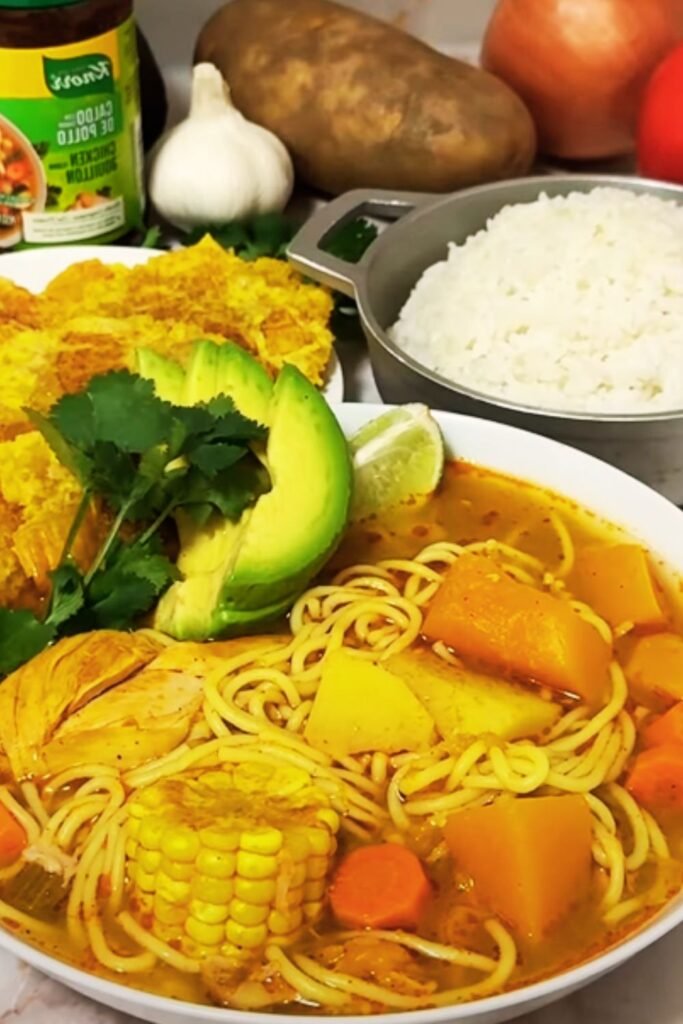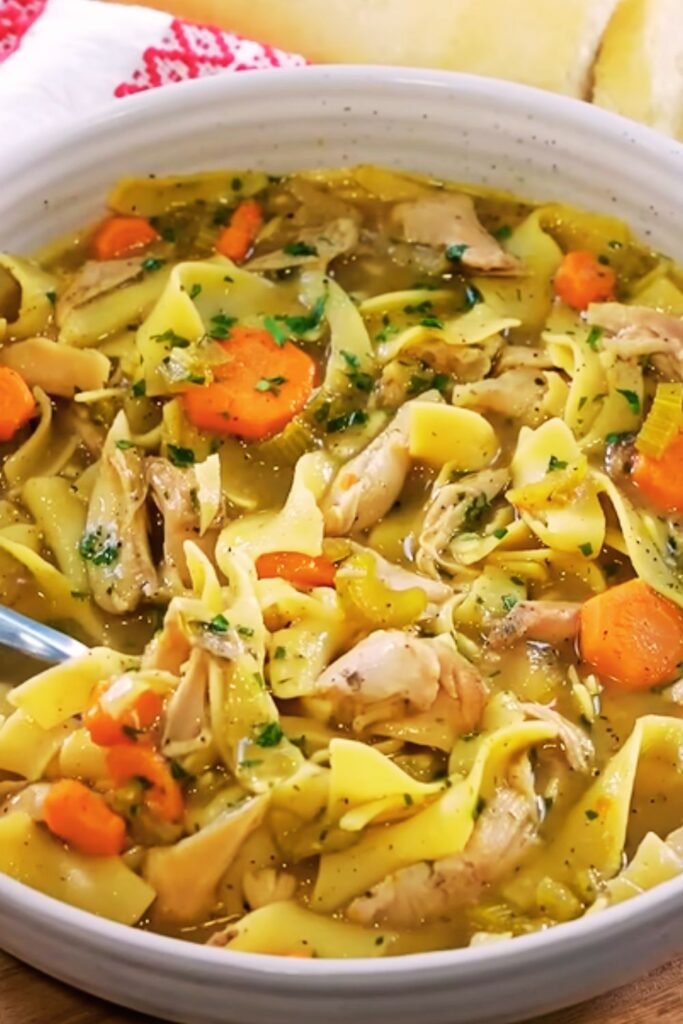There’s something undeniably magical about a steaming bowl of chicken noodle soup, especially when it’s made with roasted chicken that brings an extra depth of flavor you simply can’t get from boiled meat. When I first started making this soup years ago, I had no idea it would become my family’s most requested dish during chilly weather. The rich golden broth, tender vegetables, perfectly cooked noodles, and succulent roasted chicken pieces combine to create the ultimate comfort food experience that nourishes both body and soul.
Why Roasted Chicken Makes All the Difference
Most traditional chicken noodle soup recipes call for boiling raw chicken pieces directly in the broth. While this method works fine, roasting the chicken first transforms this everyday soup into something truly extraordinary. When you roast chicken, something magical happens – the Maillard reaction creates hundreds of new flavor compounds that simply don’t develop during boiling.
I discovered this technique quite by accident. One chilly autumn evening, I had leftover roasted chicken from dinner and decided to use it in the next day’s soup instead of raw chicken. The difference was immediately noticeable – the broth had a deeper, more complex flavor that elevated the entire dish. My husband, who typically views soup as “just a starter,” ate three bowls and declared it a meal in itself!
The roasting process also gives you those delicious crispy skin bits and caramelized pan drippings that can be incorporated into your broth, adding incredible richness and depth. Trust me on this one – once you try chicken noodle soup with roasted chicken, you’ll never want to go back to the boiled version again.
Essential Ingredients for the Perfect Soup
The beauty of this soup lies in its simplicity. You don’t need exotic ingredients or complicated techniques – just fresh, quality components treated with care.

The Foundation Components
- Whole chicken: Choose a 4-5 pound free-range bird if possible; the flavor difference is noticeable
- Aromatics: Yellow onions, carrots, celery (the classic mirepoix), plus garlic
- Herbs & Spices: Fresh thyme, bay leaves, whole black peppercorns, and fresh parsley
- Broth enhancers: Chicken feet (optional but recommended for gelatin-rich broth)
- Acid: A small amount of white wine or lemon juice to brighten the flavor
- Noodles: Egg noodles are traditional, but any pasta works
- Finishing touches: Fresh herbs, a squeeze of lemon juice, and high-quality salt
I’ve experimented with countless variations over the years, but I always come back to these core ingredients. The trick isn’t adding more things – it’s treating these simple ingredients with respect and allowing their flavors to shine.
Step-by-Step Method
Step 1: Roast the Chicken
This crucial first step sets this soup apart from ordinary chicken noodle versions.
- Preheat your oven to 425°F (220°C)
- Remove chicken giblets and pat the chicken dry with paper towels
- Rub the chicken all over with olive oil, salt, and pepper
- Place in a roasting pan and add a quartered onion, carrot chunks, and celery pieces around it
- Roast for 70-90 minutes until the internal temperature reaches 165°F (74°C) and skin is golden brown
- Let the chicken rest for 15-20 minutes before removing the meat
Chef’s Tip: Don’t discard the roasting pan juices! These concentrated flavors are gold for your broth.
Step 2: Make the Broth
While store-bought broth works in a pinch, homemade broth elevates this soup to something truly special.
- Place the chicken carcass, skin, and any unused parts (except liver) in a large stock pot
- Add roasting pan drippings (skim excess fat if desired)
- Add 3 quartered onions, 4 roughly chopped carrots, 4 celery stalks, 1 head of garlic (halved horizontally), 3 bay leaves, 1 tablespoon whole peppercorns, and a small bunch of thyme
- Add 2 chicken feet if using (these add incredible body to the broth)
- Cover with cold water by 2 inches (approximately 12-14 cups)
- Bring to a bare simmer (never boil vigorously)
- Maintain a gentle simmer for 3-4 hours, occasionally skimming any foam
- Strain the broth through a fine-mesh sieve lined with cheesecloth
- Season with salt to taste
Pro Tip: For an even richer broth, refrigerate overnight and remove the solidified fat from the top before proceeding.
Step 3: Prepare the Soup Components
Now it’s time to prepare the vegetables and chicken that will go into the final soup.
- Dice 2 onions, 4 carrots, and 4 celery stalks into uniform pieces
- Finely mince 4 garlic cloves
- Shred or dice the roasted chicken meat into bite-sized pieces (you’ll need about 3-4 cups)
- Chop fresh parsley and dill for garnish
- Measure out 8 ounces of egg noodles
Step 4: Assemble and Cook the Soup
This final phase brings everything together into a harmonious whole.
- In a large pot, heat 2 tablespoons olive oil over medium heat
- Add diced onions, carrots, and celery with a pinch of salt
- Cook until vegetables begin to soften, about 5-7 minutes
- Add minced garlic and cook for 30 seconds until fragrant
- Pour in prepared broth (about 10 cups)
- Add 2 fresh bay leaves and a few sprigs of thyme
- Bring to a simmer and cook until vegetables are nearly tender, about 10 minutes
- Add egg noodles and cook until al dente (follow package directions minus 1 minute)
- Add shredded chicken and simmer just until heated through
- Remove from heat and stir in 2 tablespoons fresh lemon juice
- Taste and adjust seasoning with salt and pepper
- Garnish with fresh herbs before serving
Important Note: If you plan to have leftovers, consider cooking and storing the noodles separately to prevent them from absorbing too much broth and becoming mushy.
The Science Behind a Perfect Chicken Soup
I’ve always been fascinated by the culinary science that makes a great chicken soup so nourishing. Here’s what’s happening behind the scenes:
Nutritional Profile of Homemade Roasted Chicken Noodle Soup
| Nutrient | Amount per Serving | Benefits |
|---|---|---|
| Protein | 26g | Supports immune function and tissue repair |
| Collagen | High | Derived from bones and connective tissue during long simmering |
| Zinc | 2.1mg | Crucial for immune cell development and function |
| Vitamin A | 5840 IU | Supports mucous membrane health and immunity |
| Vitamin C | 12mg | Antioxidant that enhances iron absorption |
| Selenium | 24mcg | Important for thyroid function and antioxidant defenses |
| Carbohydrates | 22g | Energy source from noodles and vegetables |
| Fiber | 3g | From vegetables, supports digestive health |
| Sodium | 860mg* | Varies based on salt added, supports fluid balance |
*Note: Sodium content can be adjusted based on dietary needs
Why Chicken Soup Really Does Fight Colds
The old wives’ tale about chicken soup being good for colds actually has scientific backing. Research from the University of Nebraska Medical Center found that chicken soup inhibits the migration of neutrophils (inflammatory white blood cells), which can help reduce upper respiratory cold symptoms.
Additionally, the warm broth:
- Helps loosen mucus and clear nasal passages
- Provides easy-to-digest nutrition when appetite is low
- Delivers hydration with electrolytes
- Offers compounds that may have mild anti-inflammatory effects
The roasting step in this recipe amplifies these benefits by creating additional bioactive compounds through the Maillard reaction, potentially enhancing the soup’s therapeutic properties.
Storage and Freezing Guidelines
One of the great joys of making this soup is having it available whenever needed. Here’s how to store it properly:
Refrigerator Storage
- Store soup in airtight containers in the refrigerator for up to 4 days
- Keep noodles separate if possible to prevent them from absorbing too much liquid
- Reheat gently on the stovetop until just simmering
Freezer Storage
- Freeze without noodles for best results (add fresh noodles when reheating)
- Use freezer-safe containers or heavy-duty freezer bags
- Leave 1-inch headspace for expansion
- Label with date and contents
- Keeps well for up to 3 months
Reheating From Frozen
- Thaw overnight in refrigerator (preferred method)
- Heat gently on stovetop until simmering
- Add fresh noodles during last few minutes of heating
- Adjust seasonings as needed (flavors often dull during freezing)

Serving Suggestions and Variations
While this roasted chicken noodle soup is perfect on its own, here are some ways to turn it into a complete meal or customize it to your taste:
Accompaniments
- Crusty artisan bread or buttermilk biscuits
- Simple green salad with vinaigrette
- Grilled cheese sandwich for the ultimate comfort food pairing
- Avocado toast for a modern twist
Flavor Variations
- Herbs: Try different herb combinations like rosemary, sage, or tarragon
- Spicy: Add red pepper flakes or a dash of hot sauce
- Creamy: Stir in 1/2 cup of cream or coconut milk at the end of cooking
- Lemony: Increase lemon juice and add lemon zest for brightness
- Garlicky: Roast a whole head of garlic with the chicken and add to the broth
Dietary Adaptations
- Gluten-Free: Use rice noodles or gluten-free pasta
- Low-Carb: Substitute zucchini noodles or cauliflower rice for pasta
- Extra Vegetables: Add spinach, kale, peas, or corn
- Grain Alternative: Use wild rice or farro instead of noodles

Troubleshooting Common Issues
Even experienced cooks occasionally encounter challenges when making soup. Here are solutions to the most common problems:
Cloudy Broth
- Cause: Boiling the broth vigorously instead of simmering
- Solution: Maintain a gentle simmer with just a few bubbles breaking the surface
Greasy Broth
- Cause: Too much fat from the chicken skin or roasting pan
- Solution: Make the broth a day ahead and refrigerate overnight. The fat will solidify on top and can be easily removed.
Bland Flavor
- Cause: Insufficient seasoning or not using roasted components
- Solution: Add salt gradually throughout the cooking process rather than all at once at the end. Also, ensure you’re incorporating all the roasted chicken drippings from the pan.
Mushy Vegetables
- Cause: Overcooking or cutting vegetables too small
- Solution: Cut vegetables into uniform, slightly larger pieces and add them to the broth with enough time to cook through but not become mushy.
Noodle Problems
- Cause: Noodles absorbing too much broth or becoming soggy
- Solution: Cook noodles separately and add to individual bowls when serving, or cook them just under al dente if adding directly to the soup.
Questions & Answers
Q: Can I use a rotisserie chicken instead of roasting my own?
Absolutely! A store-bought rotisserie chicken is a fantastic time-saving option. Just be sure to save all the juices and skin for your broth. The flavors won’t be identical to home-roasted chicken, but it will still be delicious and significantly better than using raw chicken.
Q: How long should I really simmer the broth?
For optimal flavor extraction, I recommend 3-4 hours minimum. However, even 1-2 hours will produce a good broth. The longer you simmer (up to about 8 hours), the more collagen and minerals will be extracted from the bones, creating a richer, more nutritious broth. Just be sure to maintain a gentle simmer, never a rolling boil.
Q: My soup tastes a bit flat. How can I improve the flavor?
The most common reason for flat-tasting soup is insufficient salt. Remember that a large pot of soup needs adequate seasoning. Try adding salt gradually, tasting as you go. Also, a splash of acid like lemon juice or a teaspoon of vinegar can brighten flavors dramatically. Finally, don’t underestimate the power of fresh herbs added at the end of cooking.
Q: Can I make this in a slow cooker or pressure cooker?
Yes, with modifications. For a slow cooker, you’ll still want to roast the chicken separately first. Then proceed with making the broth in the slow cooker on low for 8-10 hours. For a pressure cooker, again, roast the chicken first, then make the broth under pressure for 45-60 minutes. The soup components can then be cooked using the sauté function.
Q: How do I prevent the noodles from getting soggy in leftovers?
This is a common issue! The best solution is to cook and store the noodles separately from the soup. When ready to serve, place noodles in the bowl and ladle hot soup over them. If that’s too much trouble, another option is to slightly undercook the noodles initially, knowing they’ll continue to absorb liquid during storage.
Q: Is there a way to make this soup even more immune-boosting?
Absolutely! Try adding immune-supporting ingredients like:
- 1-2 inches of fresh ginger, minced
- 2-3 cloves of garlic (in addition to what’s already in the recipe)
- 1/4 teaspoon turmeric
- A handful of shiitake mushrooms
- Extra vegetables high in vitamin C like bell peppers
Q: Can I make this vegetarian?
While you won’t get the same roasted chicken flavor, you can create a delicious vegetarian version by:
- Roasting vegetables like onions, carrots, celery, and garlic until caramelized
- Using those as the base for a vegetable broth with herbs and spices
- Adding protein through beans, tofu, or plant-based chicken alternatives
- Using vegetable-based noodles for a complete protein
Q: My broth didn’t gel when refrigerated. Did I do something wrong?
A gelled broth indicates high collagen content, which is desirable but not essential for a delicious soup. To increase gelatin content next time, include more collagen-rich parts like chicken feet, wings, or backs in your broth. Also, ensure you’re using enough chicken parts relative to the water and simmering (never boiling) for at least 3-4 hours.
Final Thoughts
There’s something deeply satisfying about making roasted chicken noodle soup from scratch. Beyond the incredible flavor, there’s the knowledge that you’ve created something truly nourishing with your own hands. Each step of the process—from roasting the chicken to simmering the broth and assembling the final soup—contributes to a final product that’s so much greater than the sum of its parts.
I find there’s also something meditative about the process. The rhythmic chopping of vegetables, the aromatic steam rising from the pot, the patient waiting as flavors meld—it’s a form of culinary therapy in our fast-paced world. And when someone you love is under the weather, there’s no greater gift than a bowl of homemade chicken soup.
So the next time you’re craving comfort in a bowl, I hope you’ll try this roasted chicken noodle soup recipe. Take your time, enjoy the process, and know that you’re participating in a culinary tradition that spans cultures and generations. Whether you’re making it for yourself, your family, or someone in need of care, this soup delivers not just nutrition but also connection—to our food, to each other, and to the timeless human experience of breaking bread together.